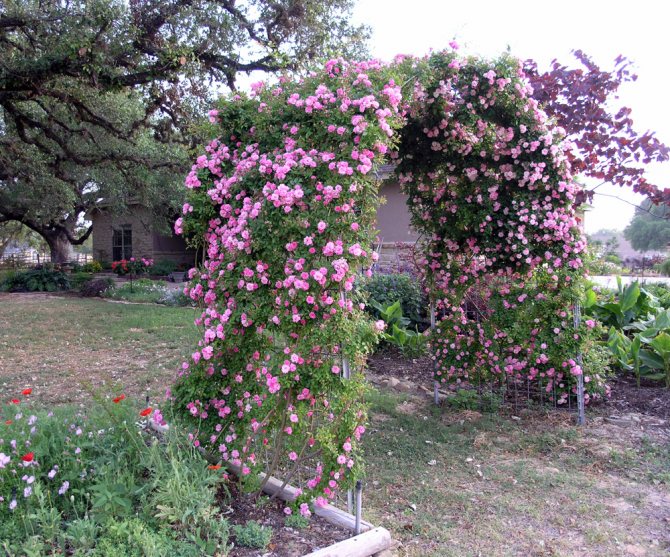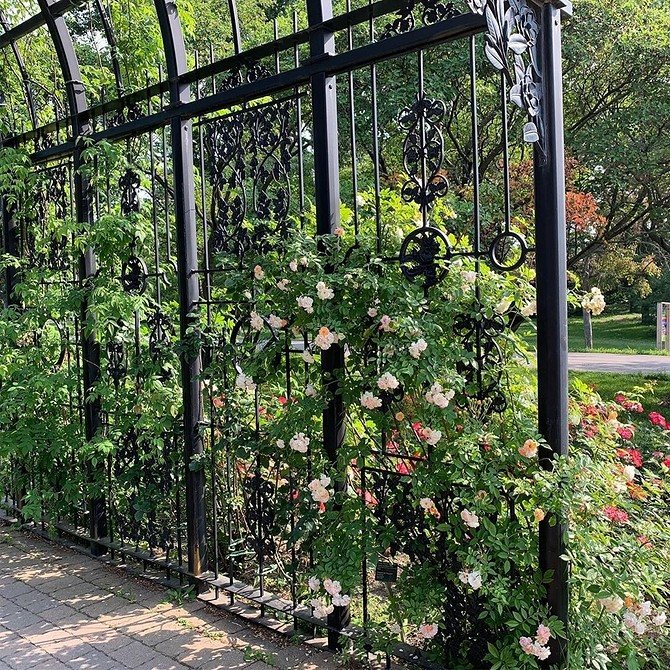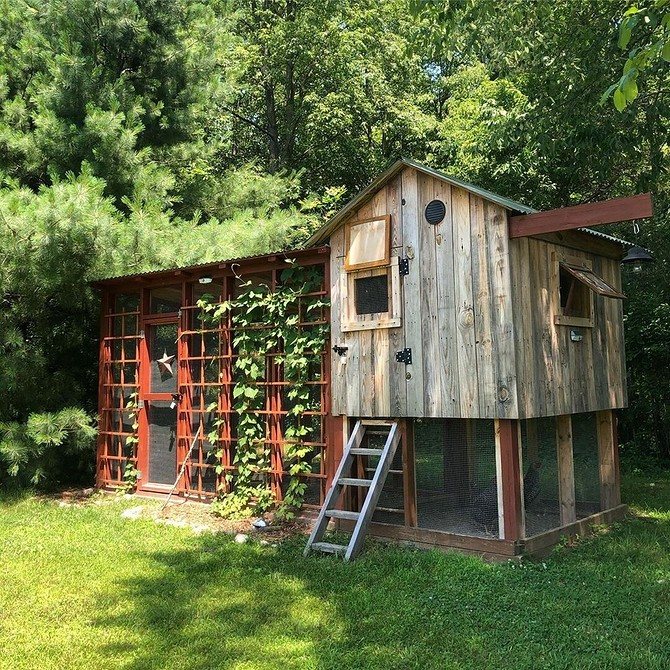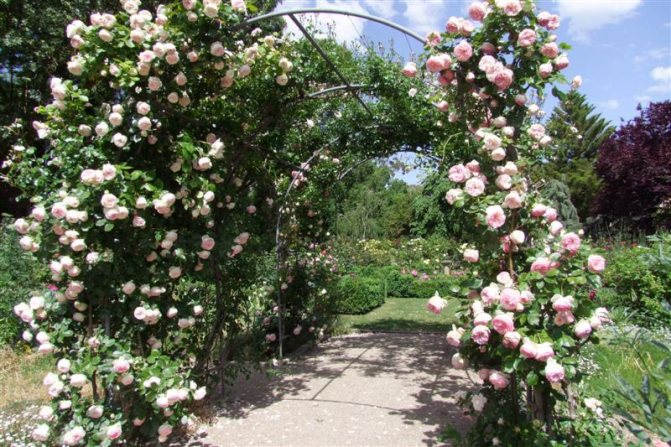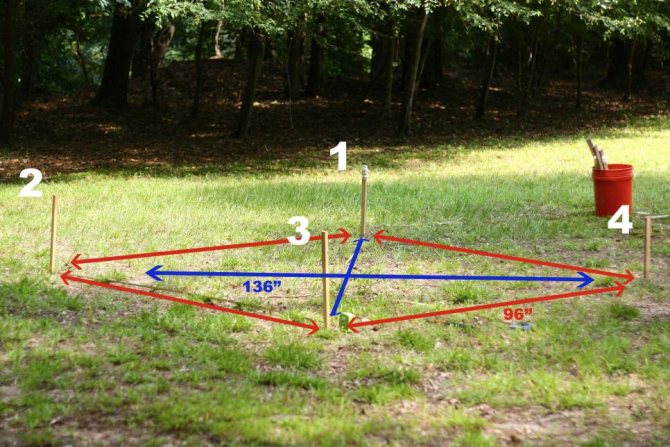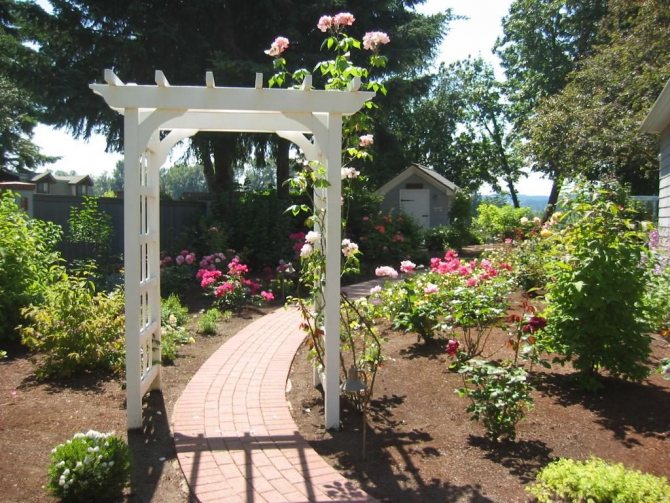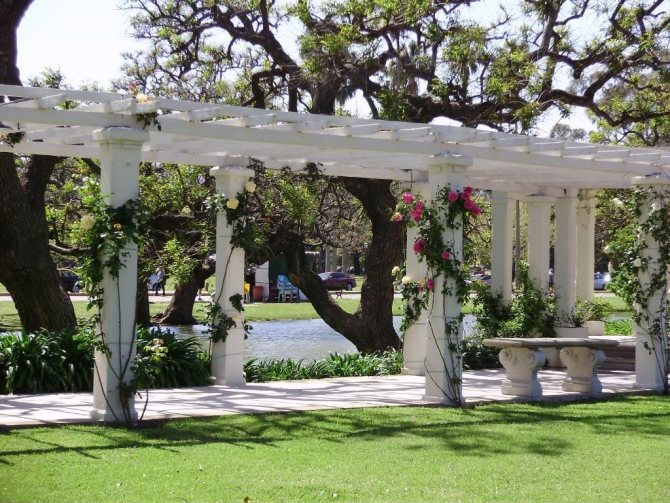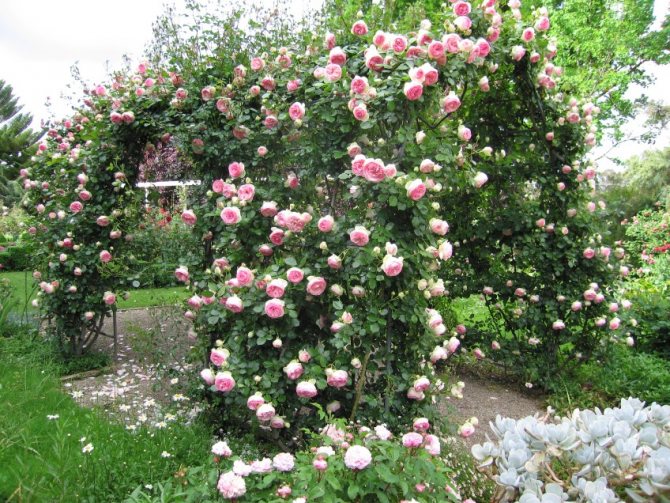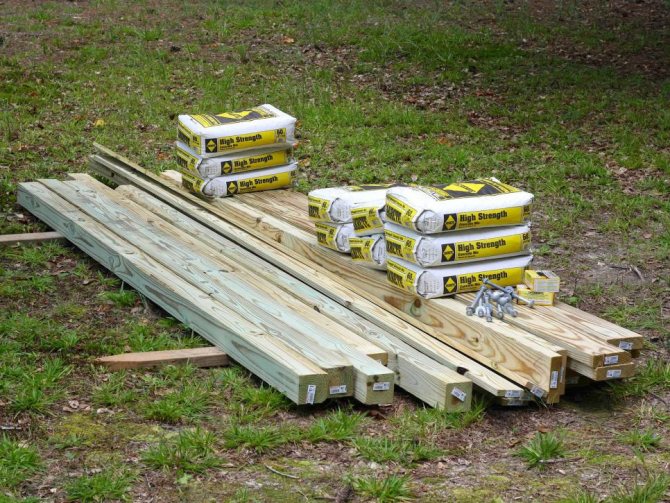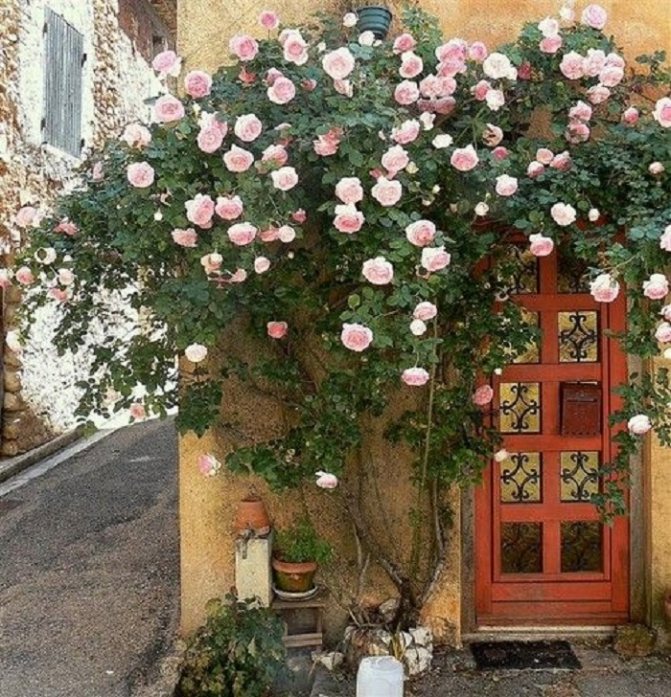Home »Building a house» Do it yourself
Do it yourself
Alexander Korovaev

Cucumbers, grapes, peas, most varieties of tomatoes, blackberries and raspberries, some types of flowers require binding to trellises or ropes to form the correct shape of the bush. We will tell you in detail how to make a do-it-yourself trellis for each of these plants.
- Types of trellises
- Grape trellis
- Single-plane trellis
- Two-plane structures
- Cucumber trellis
- Using arcs
- Using supports with horizontal beams
- Tapestry in the shape of the letter "T"
- Trellis for cucumbers
- Metal grid
- L-shaped trellis in the form of a hut
- Garter tomatoes
- Types of trellises for raspberries and blackberries
- Flower trellis
- Support for clematis
- Trellis for climbing roses
- Pea garter
Features of growing a climbing rose
The rose is known to be the queen of flowers. No one even tries to challenge her title, because this flower is graceful and perfect in its bright, exquisite beauty. The scent of a rose is its second undoubted advantage: it envelops, bewitches, attracts.
In hot climates, climbing roses can grow up to 10 meters, but in temperate latitudes - up to 3-4 meters.
Trellis mesh
Such a support can be easily made by hand. To do this, you need to dig in pillars made of wood or metal at the required distance, then pull the mesh.
To make the structure fit perfectly into the design of the site, it is better to paint the pillars in a suitable color.
Trellis mesh
The trellis can be made from wooden planks, securing them with a net between the beams. A similar design for a climbing rose will allow you to form a spectacular bush.
Arches and pergolas
These structures are an ideal solution for arranging spacious summer cottages. Arches and pergolas can also be made by hand.
Pergolas are a lattice roof fixed to pillars. The dimensions of such a support are calculated individually and depend on the design idea. The posts can be made of wood or metal.
The advantage of the pergola is that this support can also serve as a gazebo.
You may also be interested in the technology of building a summer cottage from glued laminated timber, see details.
Arches differ from pergolas in smaller sizes and curved shapes. They can be installed at the entrance to the garden or for the purpose of decorating the surrounding area. Forged or wooden arches are often made for the queen of flowers.
Poles with supports
Such supports can also be made yourself from wooden or metal rods and poles. The pillars for creating supports are very convenient: compact, not very wide. They are often used as supports for slow-curling roses.
For the climbing queen, any pillars are suitable: in the form of a column, a cylinder or a cone.
Climbing roses have neither antennae nor suckers, so they cannot grow up without additional supports.
In order to build a cone-shaped support, you need to install several wooden rods or beams in a circle and connect them at the top. A similar stand is suitable for any curly flowers.
Other types of metal supports
Many other varieties of climbing rose supports are known.Let's consider a few more options:
- support "aspiration up"
looks like a tower, made of a metal base; inside the structure there is a stand for the container, in which the fragrant flower will grow. Such a "tower" will look especially good on an open terrace;
Metal support
- metal column:
versatile and reliable. As a rule, it is made of galvanized steel, which turns it into a sufficiently strong and resistant structure to the destructive effects of the environment. - "Eiffel Tower"
: This support is a crossbeam with an openwork structure, ideal for the lateral shoots of the rose. - cross-over arcs:
they can be placed on either side of the track. A natural corridor is created, the roof and walls of which are gracefully entwined with roses. If you also install benches, then such a flowering support will make a cozy place to relax. - support-wigwam
: Suitable for an Indian style garden. To do this, you need to weave a cone from willow or birch bark with a sharp crown, to which roses will reach with their shoots. - "Steel Obelisk"
Is a support made of pipes. Ideal for roses with a slow growing season.
Grape trellis
The quality and even the yield of grapes largely depends on the choice of trellises. The support for it is made mainly two-plane. Lightweight structures located in one plane are used only for young growth, decorative or small varieties.
back to menu ↑
See also: How to embody interesting ideas for decorating your favorite summer cottage - 150+ original photo tips for craftsmen
Single-plane trellis


Semi-arch design
We will tell you in detail how to make the simplest trellis for grapes:
1 For the convenience of collecting and caring for plants, the supports should not be higher than the height of a person. It is desirable that the bunches of grapes are located no higher than eye level
2 The trellis can be made in the form of a straight columnar structure, an arch or a semi-arch. Arched structures are better illuminated by the sun, so the yield of plants with this kind of cultivation will be higher. Columnar supports or semi-arches are used more often when there is a lack of space
3 It is better to use metal as supports - such a structure will be more durable and will last much longer. After all, a vine can live up to 50 years! It will be a shame if one day it breaks along with a rotten wooden beam.
4 For the simplest single-plane trellis, it is sufficient to use support pillars located at a distance of 3 m from each other. For them, with the help of a drill, pits with a diameter of 60 cm are prepared
5 To strengthen the structure, it is better to concrete the pillars into the ground to a depth of 50-60 cm.To protect against moisture, before pouring concrete, a layer of rubble is poured into the bottom of each pit
6 Vertical crossbars are attached to horizontally located supports by welding
back to menu ↑
See also: How to cross-stitch correctly (for beginners): a step-by-step description of the steps, reading diagrams, and what materials are needed
Two-plane structures
These trellises have a large plane, which allows the vine to grow in different directions.... In this case, the plant receives more air and light, which significantly increases the yield.
Improves when tied to such supports and natural pollination. A well-grown tent creates shade, allowing the roots of the grapes to be protected from the rapid evaporation of moisture.
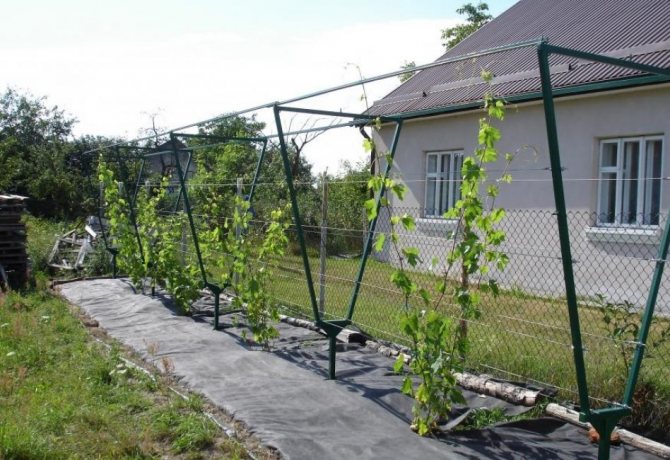

Two-plane design
Outwardly, this design resembles the letter V, fixed on a small post. In its upper part there are horizontal beams.
1The principle of creating a two-plane grape trellis is similar to the previous one.The only thing to consider when placing the supports is the gap between the rows. For the normal formation of the vine, it should be 1.5 m.A gap of 1.2 m is left between the bushes. Dessert varieties are planted at a distance of 1.5 m from each other.If the bushes are lush, it can be increased to 2 m. Between the rows leave 1.5 m
2 The optimal height of the trellis is 2.2-2.5 m
3 The diameter of the metal supports - from 32 cm.It is better to make the extreme pillars a little thicker
4 For fastening pipes, welding or metal corners and self-tapping screws are used
5 Distance between posts - not less than 2.5-3 m
6 Metal or wooden supports must be concreted in the ground.
7 To protect metal or wood from moisture, the lower part of the posts is treated with bitumen and wrapped with roofing felt
8Since the vine weighs a lot, the posts need to be given extra rigidity. For this, 4-5 rows of intermediate, horizontally running crossbars are attached between them, a thick wire or cable is pulled. Better to use copper or aluminum - the iron wire will rust quickly and will have to be changed frequently
8 To attach it to the posts, corners, rings or brackets are welded


Drawing of a grape trellis
Some growers claim that the largest bunches of grapes grow on the high supports. But this opinion is wrong. By raising the trellises to a very high height, you will only make it difficult to care for the vine.
Types for climbing roses
Although there are a great many supports for a rose, it is customary to distinguish several main types:
- arches or pergolas;
- trellis;
- lattices;
- pillars.
It should be remembered that the opinion that the rose will curl on its own, and it just needs to be provided with support, is fundamentally wrong. The main shoots of the flower must be directed so that they do not grow up, but parallel to the ground (or at least at an angle of 45 degrees) - this is the only way you can observe the abundant flowering of your pet.
In addition, whichever support you choose, it must be reliable so that the overgrown rosebush does not knock it to the ground. Also, choose a design that fits well into the general atmosphere of the site (in case the shoots do not entwine the entire structure at once). Choose the type of flower according to the structure itself: if the bush subsequently grows to a huge size, it makes no sense to build a small support for it.
Tapestry-mesh
The tapestry is the simplest and most versatile structure. As a rule, with the help of this design, the territory is divided into zones (this is how the garden can be divided, for example). It can look like a rectangular structure, which consists of a frame and a lattice inside it. The base itself and the lattice inside can be either wooden or wire. Most often, the first option is chosen, painting the structure with white paint to give it a more noble look. Although in most cases, over time, the bush grows quite strongly and the trellis is completely hidden under it.
Arches and pergolas
Very beautiful decorative structures that can even serve you as a gazebo. The pergola is a summer roof with gratings, which is designed just to be entwined with pink shoots. It can also act as a summer gazebo, in which it is pleasant to sit on a sultry day.
The bases of the pergolas are most often metal, but the roof is preferable to build from wood. Arched structures can also be made of various materials: metal ones are suitable for growing miniature flowers, but wooden ones are suitable for a plant with strong thick shoots. If there is free space, you can also put several arches located one after the other - it will look spectacular.
Cone supports and pillars
A cone support looks like a collection of several wooden beams that are installed in a circle and connected at the top.
The post is also a very convenient construction for climbing plants. It takes up very little space, while performing the necessary function. For them, those that grow very slowly are often chosen.
Choosing a variety of roses
Not all climbing roses are suitable for growing on all supports. They can all be divided into 2 types:
- scrubs;
- ramblers.
Shrubs are predominantly powerful bushes with thick, practically unbending branches. In addition, they rarely grow taller than two meters. These varieties have large flowers with a pleasant aroma. Among the advantages, they also highlight the fact that there are very few thorns on the bushes. And while it may seem that they do not need support, this is far from the case. Perhaps they will not curl along an arch or a gazebo, but at least a vertical support is simply necessary for them. Due to the weight of the flowers, the branches on such bushes can bend and simply break. The support will give the roses a more attractive look, as well as protect the bush from the wind.
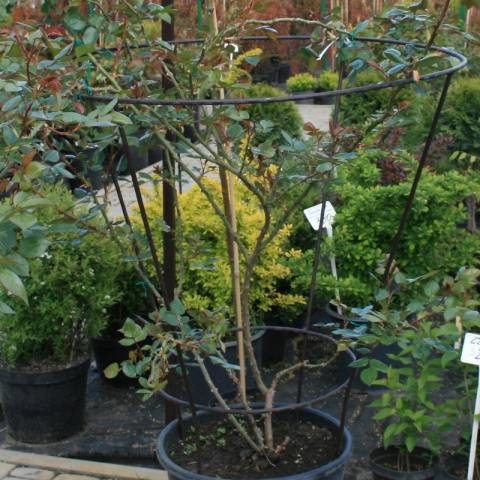

Rambler, unlike scrubs, absolutely cannot exist without support. Their branches are too thin to be able to stand on their own. These bushes can grow up to 4–5 meters in height, making them easy to adapt to any support, even the most complex structure. These plants usually have small flowers, but they are very abundant and bloom for a long time.
Remember that a support for climbing roses is not just a good decorative solution, but also a necessity. Strong winds can cause the bush to break and be badly damaged.
Important! If a wall is supposed to be a support for a rose, then the bush should be planted at a distance of at least half a meter from it. A closely planted rose will not be able to get enough air.
How to do it yourself
So, we have described the basic designs that are made for these plants. Now let's look at how to make supports for a climbing rose.
Next, you should make a vault for the arch. Around the pillars, observing the same indents, wooden bars or metal rods are installed in a circle. They are attached at the base and on the upper beam. It is along them that the shoots will subsequently curl, and they will take an almost horizontal position.
To build a pergola, you need a lattice or mesh that can be easily removed. Thus, it will serve well in the summer, and with the onset of cold weather it will be possible to remove it indoors.
The pillar is the easiest to make - it is simply driven into the ground and horizontal circular fragments made of any materials (wood, metal) are erected around the support. It is they who contribute to the required fixation of the climbing shoots, so that they twist the structure in a spiral.
For the support cone, beams made of wood or metal rods are fixed in a circle, which will converge at the top. By the way, this design can be used not only for roses, but also for other climbing plants and flowers.
- The very first and foremost rule: first make a support - then plant flowers!
- When choosing a material, be guided by the following factors: variety of roses, price category, design features.
The climbing rose looks much better than its flowerbed counterparts. However, without support, such a flower does not have the ability to curl. For branches with rose flowers, a reliable and beautiful base must be provided. To such questions - what are the types with styles, what support materials are needed, and how can you make supports yourself? - you can find the answers right now in this article.
Cucumber trellis
It is perhaps simply impossible to do without supports when growing this southern liana. The trellis provides the lashes with normal ventilation and protects them from decay. And when looking for ripe cucumbers in delicate and fragile stems creeping along the ground, there is a high probability of damage.
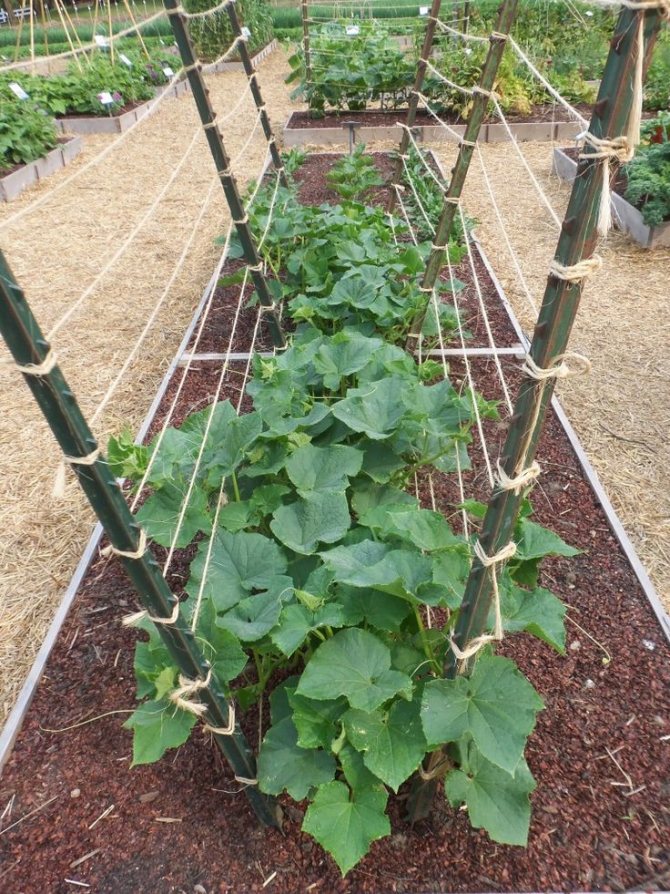

Harvesting from the trellises is a pleasure - just reach out
back to menu ↑
See also: Blackberry: a description of the 17 best varieties, cultivation features, reproduction and care (30 Photos) + Reviews
Using arcs
Open high trellises in the form of trellises are used mainly in the southern regions, where the spring shelter of these heat-loving plants is not required. In the rest of Russia, cucumbers are grown under high arches covered with foil.
At the same time, they serve as trellises - a non-slip wire or rope is suspended from them, freely hanging down. Cucumbers, growing up, themselves cling to the twine with the help of antennae.
Short arcs can be lifted higher off the ground by screwing them to wooden bars or metal pipes using self-tapping screws.
back to menu ↑
See also: How to create beautiful flower beds and flower beds in the country with your own hands? (220 fresh photos and video ideas) + Reviews
Using supports with horizontal beams
For the construction of such a structure, you can use any waste material made of wood, for example, an old picket fence.
The building materials remaining after the repair are also suitable:
1The site for planting is chosen in the most illuminated place, away from drafts.
2A couple of pillars made of solid timber or metal are buried on both sides of the garden to a depth of 0.4-0.6 m. To prevent the supports from loosening, they are driven into the ground with a hammer.
3Across the pillars, fix the horizontal crossbars.
4 Between the pillars, intermediate stakes are placed at a distance of 15-20 cm.
5A mesh between them is pulled and fixed with a strong wire or ropes are suspended. They are attached to the lower stakes near the ground, pulled up, thrown over the horizontal crossbar and fixed on the opposite side of the garden bed and the lower peg.
back to menu ↑
See also: [Instructions] Fertilizing cucumbers in a greenhouse, open field: what and when to use fertilizers | + Reviews
Tapestry in the shape of the letter "T"
To create such a structure, several support pillars are prepared. To strengthen them, 2 inclined spacer bars are used.


T-shaped trellis
All pillars are interconnected by means of the upper crossbar. On each of the upper parts of the letter "T" on both sides of the bar at a distance of 25 cm, nails are stuffed, to which a long wire is screwed or a string is tied, freely falling down to the ground.
Small loops are made at its ends, which will be thrown over young plants. You don't need to do anything else. In the future, the liana plant will itself cling to the nearest twine with the help of antennae.
The rope should not be too tight. Otherwise, the cucumbers, clinging to it and gradually pulling, will simply pull themselves out of the ground.
back to menu ↑
See also: A canopy in the courtyard of a private house made of polycarbonate and other materials (250 PHOTO IDEAS) - Beautiful view, convenience and practicality
Trellis for cucumbers
The design of such trellises can be any - they can be made in the form of a tent, hut, pedestal and even a polyhedron. The lattice cells can be rectangular, square or triangular.
back to menu ↑
See also: [Instruction] Laminate on a wooden floor with your own hands: a complete description of the process. Laying schemes, what materials should be used + Reviews
Metal grid
Strong metal mesh is able to withstand the weight of even a large number of lashes. You can also use a plastic mesh - it is strong enough plus absolutely does not rot.
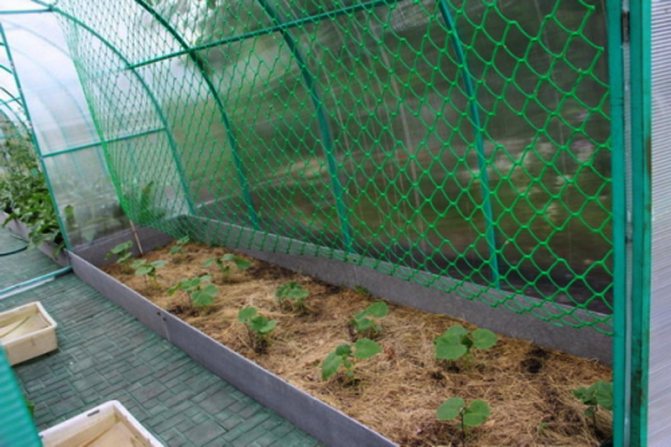

Mesh trellis
Let's describe the step-by-step process of making cucumber trellis:
1To protect the plants from the wind and prevent soil from escaping from the ridge, it is better to prepare a wooden box, which is dug into the ground, and then covered with earth on the sides.
2For the trellis, the base is made in the form of two wooden or metal boxes.
3 They are attached to the side support posts installed along the edges of the ridge, with metal corners and self-tapping screws. The pillars are driven into the ground by 40-60 cm.
4Intermediate pillars are dug in between them.
5 Next, 2-3 horizontal bars are attached.
6 The arch-shaped trellis is more convenient - it can be easily covered with a film that will not cling to the corners of the structure.
7 To give the metal mesh the shape of an arch, place a log in the center, and the edges of the mesh are brought together, adjusting them to the desired bend.
8 The net is attached to the posts from one edge of the bed to the other with nails with a thick head. They are hammered into a tree, then bent over to form a loop, to which the net later clings. Try to bend the nails in such a way that they do not cling to clothing. The plastic mesh can be simply screwed on with strong wire.
back to menu ↑
See also: How to make a patio in the country with your own hands: a variety of design, decoration and arrangement options (85+ Photo Ideas & Videos)
L-shaped trellis in the form of a hut


Trellis in the form of a hut
This design is convenient in that when the lashes grow, the cucumbers sag under their own weight perpendicular to the ground and immediately catch the eye when harvesting.
For its manufacture, a frame in the form of a hut is assembled from metal or timber, which is installed on the ground. In order not to overturn the structure, it is screwed to small pillars driven into the ground.
back to menu ↑
See also: Dishes on the fire: 15 very simple and delicious recipes for outdoor recreation |
Varieties of supports
Trellis mesh
She is one of the simplest supports. You can make it yourself without spending a lot of time and money. You can use a mesh "netting" with large cells. You can also pay attention to the rope mesh, which should be pulled over two supports. Supports provided may also work with delicate varieties of roses. You can make them by following these steps:
- You need to choose a suitable site where the support will be installed.
- Then install pillars made of wood or metal at the edges.
- Apply varnish layers to the posts.
- Attach the mesh itself.
Thanks to the lattice screen, a bush can be formed that looks like a screen. This design will help to divide your garden into separate areas.
Trellis can be made using wooden beams. It is also necessary to prepare the bar profile and nail these bars between them.
Roses that rest on a trellis can be "turned" into a fan.
Pillars made of wood, which are braided with beautiful roses, may look great. Now you need to turn the stems of the roses in the required direction. Thanks to this, a lush stand, braided with roses, will be formed. In this case, the size of the plant will also be taken into account.
A tapestry that is used against a wall can help maintain a distance of 15 to 25 centimeters. Thanks to this, the air will circulate around the bush almost all the time.
What is the support for?
Climbing varieties feature long and slender shoots. The rose needs support to maintain the vertical position of the trunks with numerous brushes of flowers. In addition to its functional purpose, the pergola is designed to perform other tasks:
- decorativeness - the supports for the bushes, correctly placed on the site, help to arrange it in an original way;
- making plants compact - without a garter, climbing roses form shapeless spreading bushes, and on a support they curl and do not occupy a large area.
In accordance with the purpose, the tapestries for roses are selected so that they correspond to the size of the bush and are strong enough. The pergola, wall or arch for roses must be stable to resist the pressure of the wind and to support the total weight of the bush.
Despite the large selection of ready-made materials, the most economical stands are made by our own efforts and from scrap materials. If the structure is completely covered with stems and leaves, the frame can be assembled from inexpensive wooden or metal elements.
Pergolas with arches
Such structures can be manufactured according to similar instructions. These supports have their own advantages. Arches with pergolas have a constant decorative effect, increased functionality and excellent capacity for rose stems.
If the bushes have thin flexible twigs, then you can use metal arches.
What are pergolas? They are a lattice roof, which is needed for twisting roses on supports (in this case, on poles). The facilities provided can replace not only a summer gazebo. They can become a whole recreation area.
The base of the pillars is in many cases metal. The top can be wooden. The exact dimensions of the pergola are selected at your own request. Such a structure is done quite simply - you just need to fix the pillars in the ground and install a wooden grate on top.
Very often, arches, which are made of wood, are erected in order to fasten roses with long stems. Bushes eventually reach the very top of the structure.
The arches are curved and small in size. The arches decorate the entrance, the garden is divided into zones, and garden paths are decorated. Most of the arches are made of wood and painted in light colors. Constructions of this type can create coziness and crystal clearness.
Forged structures are also beginning to gain popularity. Thanks to these arches, classicism (classic style) can be revived in the garden.
How to choose a material?
The material from which the rose stand is made will largely ensure the reliability of the stand. In general, when choosing one or another raw material for the production of a stand for a plant, you should be guided by the general style of your garden, its appearance. You should also pay attention to the variety of roses, since miniature plants need a stand of less strength, while for large flowers you will need a base that is larger in size. In addition, it is necessary to take into account your material capabilities - you can specially purchase material for the manufacture of a support or use the available tools that you already have on the farm.
A support for a climbing rose bush can be made from the following materials:
- wood (for example, a wooden trellis);
- metal (metal supports for pergolas);
- plastic;
- a rock.
Also, these materials can be combined with each other or use any others at your discretion.
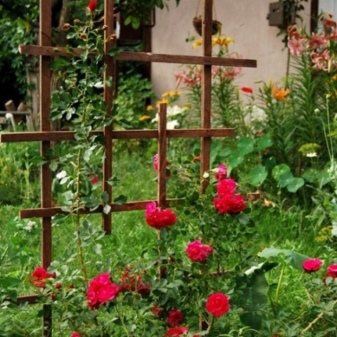

How to create?
If you want to save your family budget and show your creativity, you can make do-it-yourself rose holders. Tying roses to such a frame will be doubly pleasant. Most often, households make their own arches and trellises. Let's take a closer look at how to design such stands.
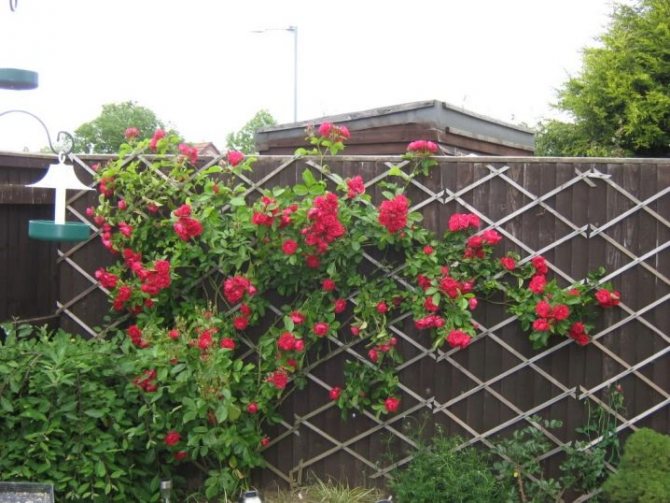

Making an arch
To make an arch, wood is most often used as a raw material (if you want to make a more "advanced" arch, a pergola, then make the base-pillars of metal, and the top of wood). First of all, it is necessary to make base pillars - for greater stability and reliability, they are dug into the ground, and sometimes they are poured with concrete. It should be borne in mind that the height of the arch should not be less than 2 meters, so take wooden poles with a margin, because some of them will go underground when fastened.
After you have made the pillars, it's time to start designing the top-arch. It is important here to accurately calculate the dimensions. Analyze this parameter in advance, and even before installing the pillars, decide at what distance they will be located from each other.
Having fixed the vault on the pillars, fasten small bars over the entire area of the arch, on which the rose will be attached. For greater aesthetics, you can paint the arch in your favorite color.
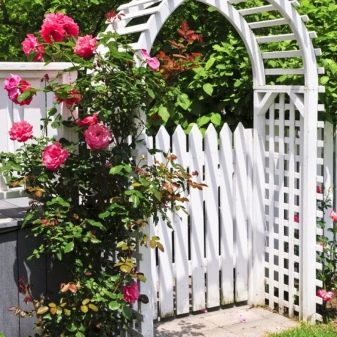

We make a trellis
The height of the trellis, like the height of the arch, must be at least 2 meters. So, first you need to dig 2 pillars into the ground, which will become the basis (watch their height). Next, a lattice should be attached to the posts, along which the rose will curl. There are several options here:
- you can use a wood grate pre-made according to the type of a screen;
- an alternative option is to fasten the chain-link mesh;
- another way out is to pull a strong wire or fishing line diagonally.
Whichever of the options you choose, make sure of its strength and reliability before forming a flower arrangement.
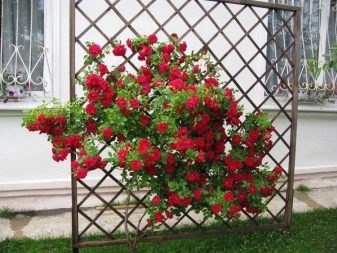

Poles with cone-shaped supports
They can be made without much effort on their own using rods of wood or metal. The result should be one pillar. Just he will be entwined with rose bushes. Moreover, its installation and reliability must be flawless. Do not forget about the required height.
When it's time to select a suitable support for a standard rose bush, you need to pay your own attention to the fact that these flowers should not stand out. The support should be placed on the thickest side of the plant.


For the correct cultivation of a standard rose, it is necessary to pick up a not short and reliable rosehip shoot. Its height should be between one and two meters. At a height of half to one and a half meters, you need to plant a varietal rose.
To make a support with the appearance of a cone, it is necessary to fix rods or beams made of wood in a circle. They should be joined together at the top. In addition to climbing roses, these cone-shaped structures can become a support for other flowers that can curl. So, the support cone allows all the enthusiasm to be used to realize any kind of decorative flower structure.
There is no way for a rose to curl on its own. So she needs direction and tying up. If the garter passes, then the branches must be directed to the side. Thanks to this, shoots are formed, which begin to grow upward.
The trellis support must be characterized by such parameters as strength and stability. Otherwise, the wind can overturn such a structure without any problems.
Regardless of which option was chosen as the support of the climbing rose bush, it is necessary to plant these flowers correctly. Do not forget about caring for this plant. You need to make sure that the roses are trailed correctly, cut off excess shoots in a timely manner and feed your own roses with a variety of fertilizers. Then these flowers can decorate every building and the entire garden.
What should be a trellis for roses
It is wrong to think that a climbing rose just needs to be planted by a fence or a wall, because the flower will not find a place for weaving on its own. There are a number of requirements that must be observed when making a trellis for climbing plants with your own hands:
- Reliability and durability. The base must have good stability, and must also be well fixed so that the weight of the ornamental plant does not bring down the structure. Any support must be buried securely in the ground or secured with metal stakes. Some heavy flowers can bend under their own weight a support made of poorly selected material, such as plastic.
- Decorativeness. A do-it-yourself trellis should be picturesque and harmoniously fit into the exterior of the garden plot, especially when the plant does not completely entwine it
- Combination with a variety of flowers. A bulky stand is not suitable for small roses, and a miniature one will not be able to support tall and large plants.
- Compactness. It is not advisable that the support takes up a lot of space on the site. When installing, take into account the length of the flower shoots and how much space is needed to form a thick and beautiful bush.
- Economy. In order not to spend money on ready-made arches, stands and supports, you should make all this with your own hands.
- The tapestry must be made of materials that are environmentally friendly. The rose is not capricious, however, during the flowering period, not only water for irrigation and soil should differ in purity, but also the material that was used in the manufacture of the support.
- The support should be simple to manufacture and operate.
It is interesting: Sudanese rose - description and growing of a flower
Common mistakes when tying climbing roses
When tying lashes of roses of any variety, it is important not to make three mistakes:
- Overly stiff garter.
The epidermis of the stem of a rose is strong enough, however, it can also be injured by an overly rigid garter. Pathogens easily penetrate into a place with a torn bark, and the infected shoot will have to be cut off.
- Pole fastening in many places.
Trying to firmly fix the shoots, we must not forget that in the fall they will need to be removed and laid under cover. Multiple garters will make this task much more difficult. It is enough to wrap the lash of ramblers around the support in 2-3 turns and tie only at the top. Climber shoots are tied up in 2-3 places.
- Fastening to a flimsy support.
In the midst of flowering, climbing roses become very heavy. If the support is not strong enough, any wind will overwhelm it, forcing the grower to work hard to untie and lift the bush from the ground, and then restore the structure.
Tip # 1. Climbing roses have been growing in one place for many years. Therefore, it is advisable to mount the support already during the preparation of the planting pit, cementing the base.
General rules for the care of a climbing (curly) rose
Climbing rose seedlings have an open root system, therefore, before planting, for a day, they must be left in water. The plant is planted in spring. Before planting, it is necessary to cut the rose into two shoots, this is about 30 cm. The stems are not cut in autumn, this procedure is carried out only in the spring. The root system is cut by 25 cm. After planting, the bush is sprinkled with pre-crushed charcoal. This is done for disinfection.
When caring for a climbing rose, you need:
- Watering. In the summer, the old climbing rose can be without moisture for a long time, nevertheless, flower growers still recommend watering the plants as the soil dries out. This is done under the very root system in the late evening or early morning. Powdery mildew is a common plant disease. It appears if a lot of moisture gets on the leaves. It is forbidden to water the plant little by little and often.
- Top dressing. The quality of flowering and the growth rate of the climbing rose directly depends on the feeding. If you do not give the plant useful substances, then it ceases to bloom profusely, loses its ability to maintainability. Top dressing is of two types: root and foliar.
- Mulching. During this process, moisture is retained in the soil, the growth of weeds is blocked, the plant is additionally fertilized. Peat, manure, mowed grass, leaf humus, chopped bark are suitable for mulching.
- Loosening. To improve the aeration process and reduce the growth of weeds, loosening is carried out.
All processes must be done with the utmost care and responsibility. For each bush, it is necessary to use special supports for climbing roses. There are several types of rose props:
Arches, trellises or ladders: what to choose?
Horticultural centers offer various ready-made design solutions for vertical gardening:
| Construction form | Features of the | Approximate cost, rub. |
| They are made of metal and can include forged decorative elements. Suitable for landscaping with rose ramblers. | ||
| Trellis (lattice panel) | They do not exceed 2 meters in height. The standard width of one span is 1 meter. At least two spans are usually purchased for roses. Suitable for landscaping with climbers. They fit worse under ramblers - only when starting the lashes in the horizontal direction. | 5700 for 1 span |
| Narrow construction, about 40 cm wide. It can be classic wooden or forged, figured. Height is no more than 2 meters. Suitable only for letting the rambler onto the wall, after which the lashes will need additional support and a garter. | ||
| Lattice screen with flowerpot | They represent a wooden or plastic trellis with a lattice, in the lower part of which there are boxes for planting plants on both sides. Suitable for container growing of climbers, if the depth of the box is at least 60 cm, and the width of the screen is at least 2 m. | |
| Lattice arch for creating flowering tunnels, at least 140 cm wide. It can be wooden or metal, with forged elements. Suitable for landscaping with ramblers. |
The location of the supports for climbing roses depends on the design intention of the florist. So you can arrange the entrance to the site or to the house, create an arched tunnel above the path, or put up a support with a rose as the central figure in the rose garden.
The illumination of the area on which the climbing rose will be located is of great importance.
It is necessary to choose the brightest place, protected from cold winds, since in the shade roses bloom worse and grow more slowly.
Supports for clematis
Anything can serve as a support for clematis. It all depends on where the plant is planted. At the windows, it can become an impromptu frame. Wrapping around the supports, it will decorate the facade of the house in the shape of the window. In addition, it will create a shadow, and during flowering, a wonderful view of greenery and bright flowers - stars will open from the house.
This flower will perfectly decorate the porch of the house or the veranda. Moreover, architectural elements will become the pillars. On the veranda entwined with clematis it will be comfortable to receive guests, or enjoy reading a book.
Another interesting option is planting clematis near a garden bench. The plant will curl along the frame and create a shadow. And it is also a great option for decorating a personal plot.
In addition, you can disguise a blank wall or fence with weaving flowers. Thus, you will decorate your site with flowers and hide the ugly place.
And of course, the classics of the genre, clematis on the garden arch. This option is suitable for owners of large plots where it is visually necessary to separate the vegetable garden from the lawn. Passing through the arch with flowers, you will find yourself on another part of your yard. These are the options you can choose from.
Diy obelisk for a climbing rose
Supports for climbing roses are expensive. However, you can minimize costs and do it yourself. The easiest option is to arrange a pyramidal structure. These are sold in garden centers, but they, as a rule, are not high enough (1.5 m) and are not suitable for vigorous ramblers.
For the independent construction of an obelisk for roses, you will need two 6-meter boards 25 mm thick, wooden slats 25 mm wide, a hacksaw or jigsaw, as well as self-tapping screws. The sequence of work is as follows:
- cut 1 meter from each board;
- divide each segment in half and set aside;
- Divide the remainder of the boards into 2.5 m segments;
- dissolve the boards lengthwise into 4 cm wide slats;
- make a spacer from half-meter segments to the lower part of the obelisk;
- fix the rail spacers at the corners and connect them from above;
- between the legs of the obelisk, fix the cut thin slats in the form of a ladder.
Climbing roses are planted on all four sides of the obelisk. As they grow, blooming "pillars" are formed.
Supports for cucumbers with their own hands in the open field
With your own hands, you can make a variety of supports for cucumbers. If after the repair you still have plastic pipes and you don't know where to put them, now we will tell you. We set aside a place where the planting of cucumbers is supposed to be. After that, we fix two pipes about 2 m high in the ground at a distance of 1.5 - 2 m from each arc. On top of them we put another pipe with a length slightly larger than the distance between the pipes.On the sides of each of the vertical pipes, we also install supports with a height of 1 m.After that, we connect the side posts with an improvised ridge and mount the horizontal crossbars. Now you can plant cucumbers both in the ground and in containers installed on stands.
The easiest option is to install pillars or fittings on the garden bed along which the cucumbers will curl as they grow. A chain-link mesh can serve as an excellent support. Having fixed it on the frame, we set it in the shape of a triangle on the garden bed. The plant will trail along it. It will also save space on the site.
Arched pergola for a climbing rose with your own hands
A pergola entwined with roses is an extremely effective element of the garden decor. You can also build it yourself:
- dig in wooden beams or metal pillars with a step of 1.5-2 m in two rows - opposite each other;
- tie them together with a lattice of rails or metal rods;
- tie the rows together with the same lattice on top.
Roses are planted on the outside of the rows and sent up the trellises. After 3-4 years, long-leaved ramblers are able to completely close the pergola.
The pergola allows the landscape designer's fantasies to roam. For example, it is possible in this way to assemble not a solid tunnel, but a series of wide arches, slightly spaced from each other. This option is nice because it does not create a large shading area.
Another effective use of a pergola is to create a decorative porch in front of the house. Also, with its help, you can successfully arrange a summer veranda.
Tip # 2. It is not necessary to buy any expensive material for a pergola. Today, the rustic style is very popular in landscape design. Its peculiarity is the use of natural materials with minimal processing. For a pergola in a rustic style, for example, large branches of garden trees that are roughly tied together after pruning are suitable.
Pergola for roses
A pergola for roses can be made with your own hands in the form of an arch. A pergola entwined with roses will look very impressive in the garden.
Instructions for making props for climbing roses:
- dig in metal posts (wooden beams) parallel to each other, with a step of 2 m;
- fix a wooden or metal lattice between them;
- fix the same grid on top.
Pergola for roses
The plant must be guided up the trellis, planted from the outside. The perlog will close completely in 3-4 years. It is best to choose varieties of long-leaved ramblers: Crimson Rambler, Lyon Rambler, etc.
Leading lashes of a rose along the wall of the house
This option is suitable for both ramblers and climbers. The only difference is the height of the structure. For climbers, width is more important than height. Long-haired ramblers can be positioned on the wall upward, in breadth, and in a fan.
To send a climbing rose along the wall, you need to plant it at a distance of about 50 cm from the building.
So the plant, on the one hand, will have enough space to form a good root system, and on the other, the lashes will freely reach the first support.
There are three common options for supports for weaving roses on the wall:
When decorating buildings with climbing roses, it is important to keep in mind one nuance: it is undesirable for the shoots to adhere closely to the wall, especially if it is wooden. In this case, the wall may get damp. Therefore, the installation of the supports must provide for some clearance for good aeration.
Garter tomatoes
Outdoor varieties are often easy to tie to stakes made of wood, plastic or reinforcement. The length of the stakes should exceed the average length of the mature plant by 27-30 cm.
The stakes pointed on one side are driven in almost end-to-end, at a distance of several centimeters from the bush. Tomatoes are tied to such a stake with a rope using the "figure eight" method, that is, twisting each bush twice.


Garter of tall tomatoes
But this method is only suitable for medium-sized tomatoes - powerful plants on high stems can simply fall along with the stakes. And you will have to tie up plants that are rapidly growing several times per season.
Tall greenhouse tomatoes are best secured to strong supports.
To create trellises you will need:
1Metal or wooden posts are placed along the beds. They are driven into the ground to a depth of 50-60 cm.
2A string is stretched along them with a step of 40 cm.
3Stems of tomatoes are tucked in for it alternately, and the heaviest brushes are attached using strips of cloth or thick wire. A rope that is too thin should not be used - it will damage the shoots.
4 With this method, it is often not necessary to pinch plants well-lit by the sun. You can afford to leave a couple of extra stepsons and increase yields.
Another way of attaching bushes is a linear garter... In this case, between the supports driven into the ground, a horizontal upper crossbar is attached, to which a rope is tied, the lower end of which is attached to the bush. It should not be too tight. As the plant grows with this string, you will gradually entwine new shoots.


Linear garter of tomatoes
It is not recommended to plant several years in a row on the same plant bed. In order to dismantle structures less often, you can prepare a couple of trellises and place the first year on this bed, for example, cucumbers, second peas, tomatoes or beans, etc.
back to menu ↑
See also: What vegetables can be planted before winter? TOP-8 of the most suitable plants and their best varieties | + Reviews
Garter lashes of a rose to a support
You can fix the shoots of roses directly to the support, for example, using the following materials:
| Material | Pros and cons |
| Nonwoven Tapes | Soft, elastic, do not injure the whips, hold the shoots well. The disadvantage is that they are not aesthetically pleasing enough, they require disguise. |
| Plastic rings | It is convenient to attach the lashes and remove them from the support. The disadvantage is that they slide along the support, do not withstand a lot of weight, they are only suitable for supporting thin side shoots. |
| Cuts of twine | Firmly fix the lashes to the support. Disadvantage - under high load, the epidermis of the shoots can be injured. |
When considering how to tie the shoots to the support, you need to focus on two conditions: the material should hold the weight of the whip well, but slip and squeeze it as little as possible.
Care and subtleties of the formation of a rose
After you have planted a rose and built a support for it, you need to carefully and with great care distribute the flower on the stand. Be very careful not to damage the flowers or break off the stems, in addition, try to avoid injuries caused by the sharp thorns of the rose (you can distribute the plant on the support with gloves).
When you have already distributed the rose, make sure that the new young shoots are correctly trailed along the structure, do not forget to form a beautiful floral arrangement.
Also, gardeners and landscape designers recommend not neglecting the regular pruning of the plant. Do not forget to also apply fertilizers and fertilizing to the soil (for roses, nitrogen and mineral compounds are optimal additives) - thus, the rose will actively bloom and develop.


For information on how to make a support for a climbing rose with your own hands, see the next video.
Topical questions about vertical gardening with roses
Question number 1. Is it necessary to remove roses from the support before winter?
The conditions of Russian winters are such that most climbing roses have to be covered. It is difficult to do this on a support. To reduce labor costs, you can make a support in the form of a removable lattice, which can be put on the ground without untiing the lashes from it.
Question number 2. Is it possible to put a climbing rose on a chain-link or a thread net for cucumbers?
A climbing rose can grow along the chain-link netting if the net is well stretched between the posts and fixed. Cucumber mesh is a bad option.She has a high windage, and in case of wind, the support can collapse.
Question number 3. Which support to choose for a bush rose with long falling shoots?
Such a rose can be planted in a flowerpot with a lattice screen or near any trellis. Fences are also successfully decorated with bush rose shoots.
Twisting pink stems always look more tender than their flower-bed relatives. But what kind of rose will curl without support? Blooming rose shoots need a reliable and beautiful base. Today we decided to tell you about the varieties, styles and materials of support for climbing roses, and how they can be made with our own hands.
Types of trellises for raspberries and blackberries
The bushes of these plants are quite strong and flexible, but during the ripening of the crop, they can bend under the weight of the berry. As a result, collecting it will be problematic.
Plus, the berry, touching the ground, quickly becomes dirty. To prevent this from happening, the plants are fixed with a strong wire stretched between T-, V-shaped pillars or pillars in the form of tents.


Raspberry garter
Making tapestries for raspberries or blackberries with your own hands is easy:
1 They are placed along each row of plants.
2 Trellis assembled from wood or welded from metal are buried or driven into the ground to a depth of 50-60 cm
3 Support posts are connected by wire or thick twine, capable of withstanding the weight of several bushes
4Stems of plants are attached to a string stretched near by with a small piece of thick wire
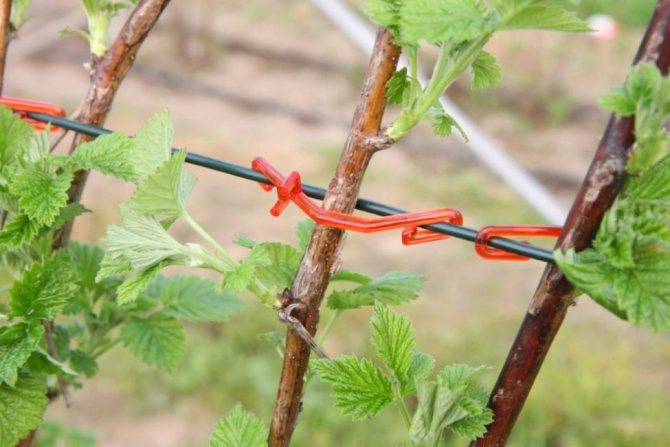

Raspberry attachment
With the help of such supports, it is convenient to fix the bushes in preparation for the winter. Plants are tilted lower to the ground and tied to the bottom row of wire stretched between the trellis.
back to menu ↑
See also: Flowerbeds and flower beds: description of varieties, original ideas for creating from scrap materials (70+ Photos & Videos) + Reviews
What should be the support for a rose?
Some beginner flower growers believe that it is enough to plant a climbing rose near the fence or wall of the house, and it will find itself a place for weaving. This is fundamentally wrong. There are several important requirements that the base for climbing roses must meet:
- Reliability.
It is better to choose a support that is stable and strong enough so that it can withstand the lush flowering branches of roses. Arches, tripods and other structures should be dug in or well anchored to the ground with iron stakes. - Decorativeness.
A stand for a rose should organically fit into the design of the site and have an attractive appearance, especially if the rose does not completely braid it. - Compliance with the rose variety.
It is not advisable to install bulky supports for miniature roses, just like too small arches will quickly "become small" for tall beauties. - Compactness.
One of the tasks of a support for a climbing rose is to compactly place it on the site. Trellis and tripods must take into account the length of the shoots and form a beautiful, densely flowering bush. - Profitability.
Ready-made arches and stands for roses are not cheap. A great way to save money is to make a support for roses with your own hands.
The support should be selected taking into account the varietal characteristics of the rose. It should easily support the weight of the bush.
Landscaping tips
Experts advise:
- Select the material for the supports taking into account the variety of roses and the design of the garden.
- Do not let the weaving of a rose take its course: regularly direct the shoots to the side; thus, upward shoots will be formed.
- The distance between the horizontal bars of the support should be at least 50 cm. If the bush is too branchy, supplement the support with additional horizontal beams.
- Large rose flowers look best on spherical large structures. For small pink inflorescences, vertical stands are suitable.
- Paint and treat the supports from time to time, otherwise they will become a source of infection.
- If the rose is planted next to a fence, wait for it to grow to it and direct it over it.
A well thought-out plan, correct location and regular maintenance will lead to a wonderful result: you will get a green oasis with fragrant flowers on the site. Carefully made supports for roses will brighten the landscape even in the non-blooming season.
Climbing rose is the most effective plant for vertical gardening of the site. The question of her correct garter is by no means idle. The problem is that the ground mass of this plant is large, and not every support will support it. The design options for supports for climbing roses will be discussed in the material.
Block: 1/9 | Number of characters: 394
Types of supports for climbing roses
Option number 1: trellis mesh
This is the simplest support that you can do yourself without a lot of time and money. You can buy a chain-link with large cages, or pull a rope net between two supports. This support is suitable for graceful pink varieties. You can do it as follows:
- Determine a place to support.
- Dig in wood or metal posts along the marked edges.
- Open the posts with varnish or paint.
- Stretch the mesh.
The trellis can also be made from thin wooden planks. It is necessary to prepare a frame of beams and fill the boards with a net between them.
With the help of a lattice screen, a bush is formed in the form of a screen. With such a structure, you can divide the courtyard into separate zones.
A climbing rose bush, supported by a trellis, can be shaped like a fan
Carved pillars made of wood look beautiful, between which fragrant pink branches weave. Now it remains to direct the stems of the roses in the right direction and form a lush blooming pink stand as the bush grows.
Using a trellis near the wall, you need to maintain a distance of 15-30 cm.This will not disturb the air circulation around the plant
Option number 2: pergolas and arches
Arches and pergolas are created in a similar way. The advantages of this type of support are constant decorativeness, functionality and good capacity for rose bushes.
For roses with thin flexible twigs, metal arches can be used as a support
Pergolas are a lattice roof for weaving roses on pillars. Such structures can serve as a summer gazebo in the garden or a recreation area. The posts are more often used in metal, and the top can be made from wood. The length and width of the pergola is selected individually. It is easy to make such a support on your own - you need to install pillars and knock down a wooden lattice over them.
An arch of wooden supports is erected for strong roses with long shoots, which, growing, can reach the top of the structures
The arches are smaller and curved. They are used for garden zoning, decorating the entrances to gazebos and decorating garden paths. Arches made of wood for climbing roses, painted white, are very popular. Such supports create the effect of suburban comfort and impeccable cleanliness of the garden. Wrought iron arches are also in demand. They look perfect in a classic style garden.
Types of trellises
A trellis is called a trellis or a rope tied to a stake, along which climbing plants cling as they grow... In some cases, this device is simply indispensable - the development of full-fledged lashes becomes impossible.
In modern landscape design, hedges, entwined with climbing plants, become a real decoration of the adjoining territories and garden plots. Simplify such support and plant care.


Inclined cucumber trellis
You can make trellises for climbing plants from any available material:
- most often structures in the form of wooden lattices are used
- decorative trellis lattices are often welded from metal
- for less massive plants, strong stakes are used, driven into the ground, with ropes tied to them
- in recent years, gardeners have begun to make tapestries from plastic water pipes; their cost is low, plus, unlike wood, they are not subject to decay
- netting
- hand-woven thick wire mesh
- for lashes with a low weight, you can use a light plastic mesh
The size and shape of the trellis depends on the type of plant and the way the stems are formed:
- grapes requires a strong and rigid support that can withstand severe loads; to strengthen the structure, it is usually concreted into the ground
- raspberrieswith dense, tree-like stems, only a little help is required in the form of trellises located on the sides of the rows
- cucumbers: high arcs, strong mesh or trellis are used to form bushes
- tomato: plants require strong enough supports of medium height
- peas: tapestries for legumes can be made from any available means, for example, thick branches of plants fastened together
- clematis: the main requirement for such supports is a often located lattice with the possibility of tying a bush
- climbing roses: for the manufacture of trellises for roses, decorative nets, wooden, metal lattices in the form of arches or decorative panels are used
It is better to paint the metal grill with light paint. Ferrous metal, when heated by the rays of the sun, will be very hot and burn the plants.
back to menu ↑
See also: Phlox - record holders for flowering: description, planting in the open field, reproduction and care (85+ Photos & Videos) + Reviews
Rambler
Rumbler roses (Rambler) have plastic, flexible shoots that are easy to direct along any support and even roll up in a ring. They do not differ in large flowers, on the contrary, this is a small-flowered form of climbing roses.
If you need to twist a decorative form in the garden (column, arch, obelisk), you should choose ramblers. Popular varieties include ‘Excelsa’, ‘Dorothy Perkins’, ‘Bobby James’.
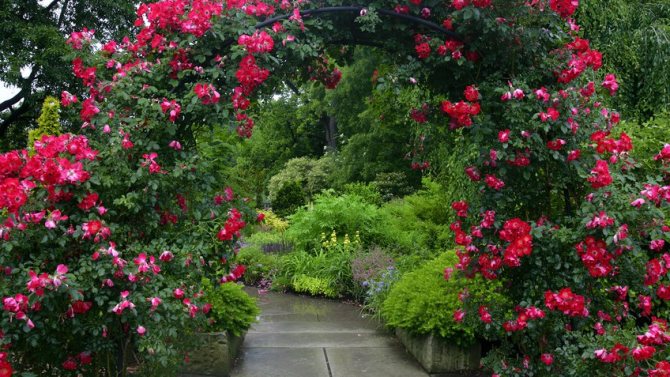

Care
Supports for climbing roses need care... It is imperative to carry out treatment with protective compounds that protect the structure from water. To prevent the supports from becoming sources of infections for the plant, they need to be painted periodically. Steel supports can last up to several decades, while wooden ones will have to be completely replaced in five years. Moreover, larch pillars will last twice as long as birch pillars.
It is enough to follow the basic rules of care for the rose bush to feel comfortable and captivate with luxurious flowering from year to year. How to properly cut bushes of climbing roses and cover for the winter - read in our materials.
Features of the trellis for lemongrass
Lemongrass loves openwork supports, they are vital to him for fruiting. The female part of the flowers of the plant is formed at a height of 2-2.5 m, and at a height of up to 1 meter there are mainly male inflorescences that do not produce fruits. For a first-year plant, it is enough to build a wicker structure with a height of 1-1.5 meters, but, starting from the second year of lemongrass's life, weaving will have to be increased all the time. If the stems of the plant do not have support, they will begin to creep along the ground, strongly intertwining with each other, which will complicate the collection and care of berries.
Possessing excellent decorative properties, lemongrass is placed on any vertical structures: ladders, wall supports, picket fence, curly trellises, on wire and mesh frames. The curly stems of the plant twine around gazebos and hedges, decorate outbuildings and sheds. The main thing is not to let lemongrass climb too high, otherwise it will be difficult to collect its fruits. The recommended construction height for this plant is no more than 3m.


To eliminate the sagging of the shoots, they are tied to the support parts from one side. When the warm season passes and winter is approaching, the trellis is laid on the ground along with the dried branches of lemongrass. The plant must be covered for the winter to preserve the root system. This procedure is especially important for areas with cold winter months.
Location
Before deciding how to make future support, consider a few points.Roses love sunny places or partial shade. The material must also withstand the scorching rays for as long as possible. In addition, regular watering and periodic fertilizing. Many of them contain chemicals that can damage the surface.
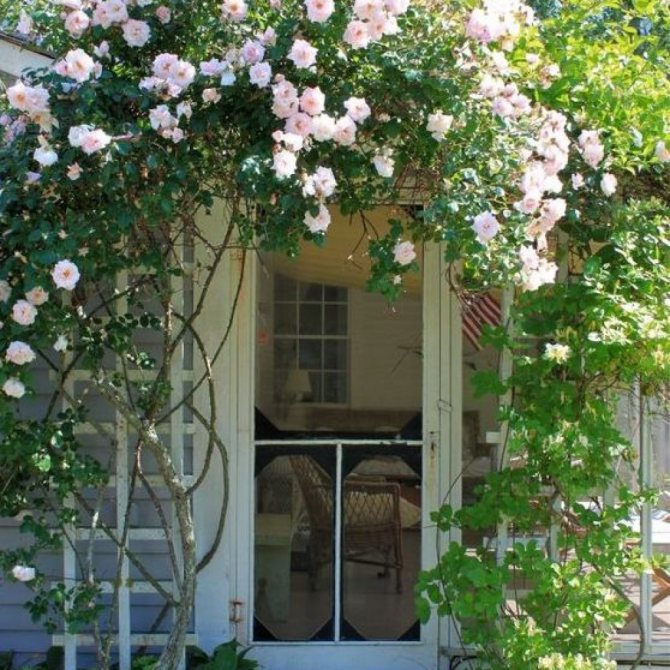

Roses in bloom are quite heavy, incl. you will need a stable panel to support their weight. A thin stick or perch won't do it. Additionally, the flowers should have good ventilation, constant access to fresh air and room for growth. This is especially important if there are trees or bushes nearby. Roses tend to take over living space for themselves and oppress cultures growing nearby. Place them so that they do not conflict with each other.
Shrubs
Many varieties of scrubs are powerful shrubs up to 2 m in height. Some varieties are so graceful that their flexible branches need support.
Since roses of this species are distinguished by abundant, lush flowering, very quickly the support will be hidden by the blossoming flowers and the bush will look like a huge bouquet of roses.
The flowers of the scrubs are fragrant, of the most varied colors. By the way, there are more fragrant roses among scrubs than among hybrid tea. Flowering lasts from June to September, and during the growing season, such roses grow by 1.5m or more.
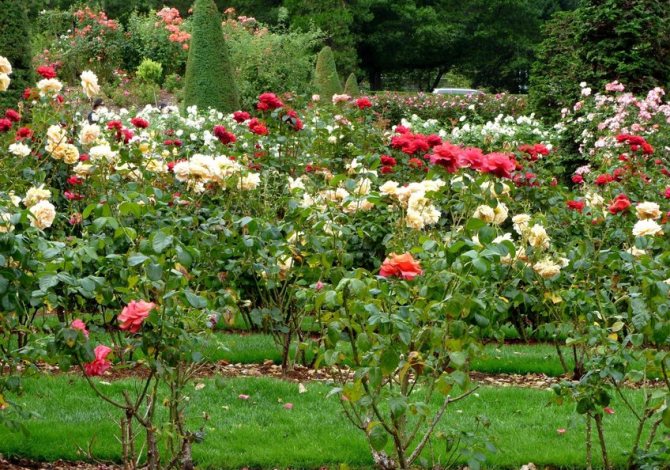

Support for grapes
- Support for grapes - a gazebo;
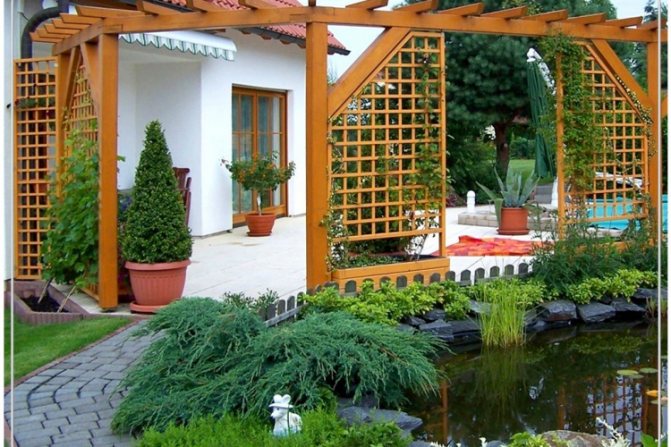

- Support for grapes - canopy;
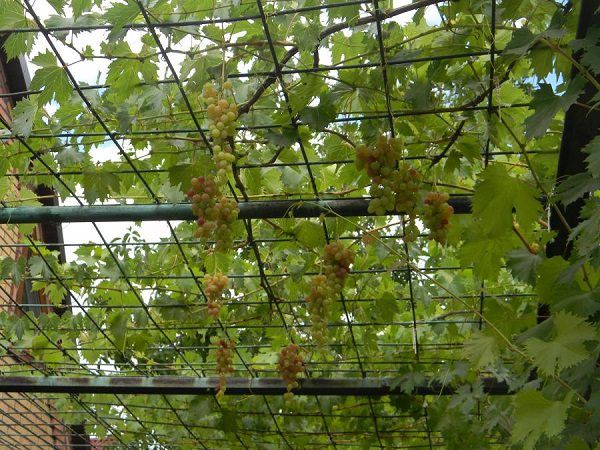

- Tapestry for grapes made of plastic.
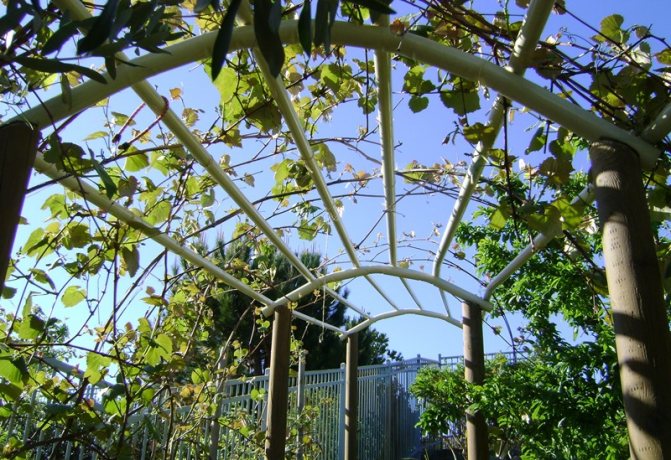

Making a wooden support
A number of materials will be needed to build a wooden support. For the most part, it all depends on the size you want to achieve. A standard arch will be described.
Fig. 1. The beams of the future arch are connected by means of a "half-tree" fastening.
You will need 12 meters of a round wooden beam with a section of 100 mm and a beam of 70 mm, 9 meters long. Also prepare:
- wire;
- pliers;
- roulette;
- level;
- some cement mortar;
- brushes;
- slats 2.5 x 4 cm.
Of course, do not forget to be patient, work carefully.
First, you need to treat the wood with anti-rot and fungal agents. The largest timber must be divided into 4 parts, each 3 meters long. Each of the segments obtained must be marked: measure 1 meter (it will be in the ground), and divide the remaining 2 meters with a pencil into 4 equal parts. The second bar, the one with a cross section of 70 mm, needs to be divided into 18 pieces of 50 cm in size. Now the process will be like assembling a constructor. Three-meter segments must be connected with half-meter segments so that two structures in the form of a ladder are obtained. It is necessary to connect the beams to each other using a "half-tree" fastening, as shown in Fig. 1.
In each interval of the "staircase", two more beams must be nailed crosswise so that the roses, as they grow, cling to them and evenly cover the arch. It remains to make the roof. It is fixed in the same way as the main structure. You need to connect all the beams according to the marks that you made earlier. The desired result can be seen in Fig. 2.
Fig. 2. The finished version of the arch for climbing roses.
At this stage of the work, it is very important to do everything with pedantic precision and check all the corners and beams with the level. Small flaws will cease to be seen as soon as the rose is wrapped around the arch, but if the structure itself mows in one direction, then over time it will only become more noticeable.
After assembling the entire arch, it remains only to install the entire structure. To do this, we dig four holes 1 meter deep so that the bases of the arch evenly stand in them. In thickness, they should be slightly wider than the bases themselves. After the structure is installed, you need to fill the pits with a solution of cement, sand and water. The mixture will need to be allowed to harden well, so it is important to guess the weather during which the installation will take place (rain and wind will have an almost destructive effect on all work). Now you can plant climbing roses to her.
Form of structures from other materials
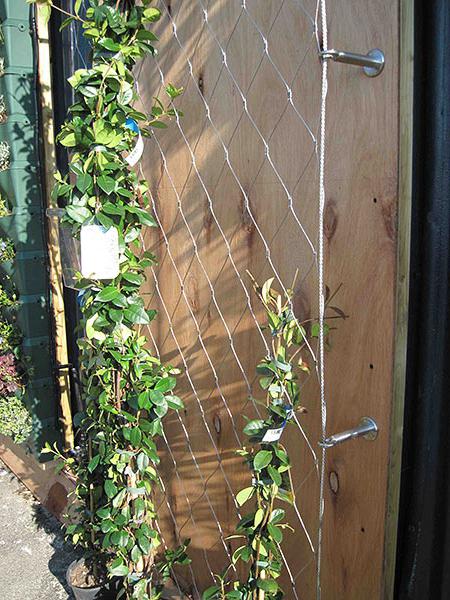

A do-it-yourself trellis for climbing plants made of plastic, wire and metal can be of various shapes. It is made arcuate, fan-shaped, horizontal, S-shaped, sliding, hipped. Such designs replace many decorated elements, intended for summer cottages. With the help of trellises, they make dream vineyards. You should pay attention to plant varieties, as sometimes you will need to use special forms.
Other types
Supports for roses are different:
- You can build a wooden structure from any bars with a height of 40-60 cm, connecting them together with 70 mm self-tapping screws, shaped like a tower, inside which there will be a small stand for a container, from which the rose will grow.
- You can make a metal column from rods with a diameter of 5 cm from galvanized steel, which will last for many years. Such rods are welded together, forming a single whole.
- You can put a steel obelisk 80 cm high from strong thin (up to 3 cm) pipes, which also have welded joints.
- You can make thin metal swing arcs on both sides of the paths by digging them into the ground 70 cm, creating a corridor of beautiful flowers. They should be quite long so that a person can pass under them without hindrance. The length also depends on the width of the track over which they will be installed. Typically up to 5 meters.
How to tie a flower?
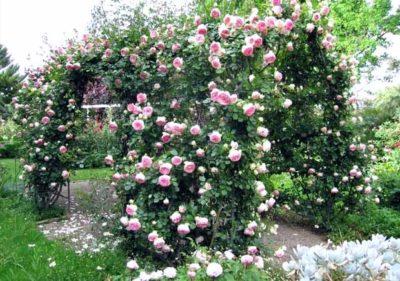

Build a structure in accordance with the size of the rose.- Plant the plant at a distance of about 40 cm from the support, or install the support at the same distance if the plant is already planted.
- Watch out for the vines, expecting a sufficient length to wrap around the structure.
- Tie the stems to the structure with twine, attaching the rose at an angle of 45 degrees.
- Anchor the vine without tying it too tightly. The plant should be able to grow unhindered.
- Pruning vines at the age of three. To do this, you need to cut the loops on the old shoots and at the base. Old stems are best removed with garden shears to make room for new ones to bloom.
We suggest watching a video on how to tie a rose correctly:
Pergola or gazebo
At the moment, almost every suburban area has a gazebo. Gazebos are considered to be very functional structures. They can be located at a short distance from the house or adjoin it, forming a kind of veranda or terrace.
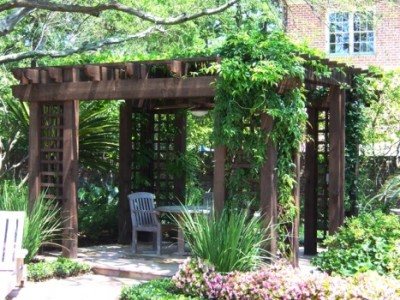

Pergola-gazebo, entwined with plants
Many believe that the pergola is just a decorative arch. But this is not the case. Pergolas can be as a free-standing decoration in a suburban area, or they can be adjacent to the house and be large. What will be better operated - a pergola or a gazebo? It all depends on the functional needs of these structures.
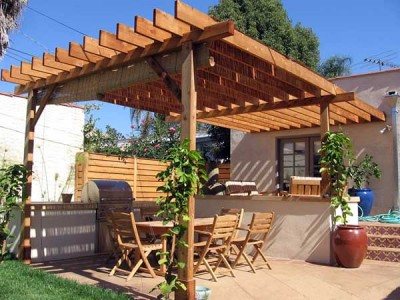

Wooden gazebo-pergola from a bar, attached to the house
Seat selection
When choosing a place for a structure, you need to think not only about where you would like to create a wonderful corner. It is very important that the rose feels comfortable in this place, otherwise all efforts will go down the drain. Unsuitable soil or too much daylight can prevent the bush from growing actively. As a result, it will not be able to curl onto the constructed object.
Roses should be planted in slightly elevated places so that water does not linger, and as a result, fungal diseases do not appear. It is desirable that from the north side the plant is slightly shaded by buildings or trees, then the cold winds will not be able to harm the growing rose. But still, they should not completely cover the bush with a thick shadow, because the rose is a photophilous plant. For the growth and formation of flowers, she simply needs the sun's rays.
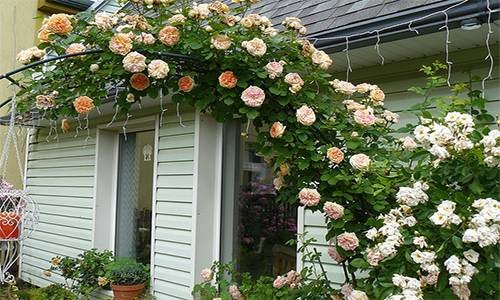

Advice! Do not plant roses in an open area where they will be exposed to direct sunlight all day. Because of this, the plant will be weak, and the flowers will wilt too quickly.
What tapestries and pergolas are made of
The material base in the case of supports for climbing plants is limited only by the imagination of their owners: the modern market pleases with a rich assortment, and you can use construction remnants and scrap materials, and they each have their own, from boards to plastic pipes. But most often, trellises and pergolas are made of metal or wood, or a frame is created from these materials, which is tightened with a mesh (metal, polymer, metal in a polymer braid).
Wooden trellises and pergolas
It can be either a rectangular frame on which transverse strips are stuffed or screwed onto self-tapping screws, forming identical cells, or two parallel supports, between which, again, there are strips or a mesh. The dimensions of the structure depend on the plant for which it will be a support and location.
Plauen FORUMHOUSE Member
And my husband made just such a trellis with his own hands. The dimensions can be changed.
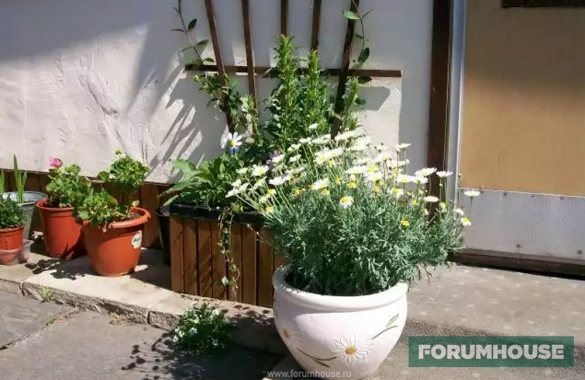

Since wood is a relatively short-lived material, and with such an application, high humidity and external influences are inevitable, in order for the trellis to serve at least several seasons, all structural elements must be protected with special means.
It is better if these are compounds that penetrate into depth and create an elastic film on the surface that protects against weather factors, but is not susceptible to cracking.
Such a film is created by paints, oils, waxes and glazes based on natural ingredients, while varnish, albeit a special one, is not the best option.
Inka FORUMHOUSE Member
We have a trellis - I needed a support for clematis, so my husband and son made me such a structure from the cheapest slats. I first covered it with an antiseptic, and then with a yacht varnish. The tapestry stood only two years, and after this harsh winter it looks deplorable - it urgently needs to be painted, in some places thin slats were pulled and twisted from snow and frost, the varnish did not protect the wood at all. Now I'll try something else.
The form and appearance are determined by fantasy and, again, fantasy based on the specifics of the application.
If we are talking about compact plants, then the trellis can be like that.
Pallas 'Pallas' FORUMHOUSE Participant
The rose is small, and we cut it regularly, and such a support is enough.
From the category of "cheap and cheerful", but effective.
Tasha Participant of FORUMHOUSE
In winter, my honeysuckle and even maiden grapes froze. And I really want everything to tighten up with greens as soon as possible. She braided the temporary hut with a grid on the principle of macrame - she imposed a base on the most ordinary shingle, "baited" on a couple of nails so that the edges would not be blown away by the wind, and grabbed them vertically with carnations. For the winter, everything can be removed, laid on the ground and covered so that it does not freeze.
A similar variation, but in the male version.
Novyi Svet FORUMHOUSE Participant
This year I built a simple wooden trellis of climbing plants. There was a small visual draft near the fence to the street, and there was also an old concrete power transmission pole sticking out there. I prepared several boards of different lengths and assembled them "by eye" (not only without a drawing, but even without a drawing). I attached two verticals to a concrete support, six horizontal lines to them, and to them an old nylon net. Fast, brutal, effective.
Another option is a cross between a trellis and a pergola.
dim-dim FORUMHOUSE Member
My tapestry is L-shaped, the supporting structure is a wooden beam 40 × 40 mm. To insure against frost heaving and rotting, first I hammered a metal corner into the ground (about 60 cm), leaving a "tail" for connection with a timber about 20 cm. Without painting, such a structure is done in three days, taking into account the plywood and with interruptions for other work ...
The case when the trellises serve as a kind of screens for the zoning of the site.
VOLCHONOK Participant of FORUMHOUSE
We decided to make ourselves a closed resting place between the house and the bathhouse. Calculations as such were not done, the height and width were estimated using a 50 × 50 mm bar, and the slats were taken with a margin, they will still be useful on the farm.They painted it with persistent paint in the color of the house, lay perfectly, stood on the house for eight years, before repainting.
No less popular among the portal participants are pergolas made of wood of two types - rectangular and arched. And they combine them not only with benches, but also with a patio.
sv56 FORUMHOUSE Member
My pergola is combined with the patio, vertical posts are embedded in metal pipes, 100 mm in diameter, and filled with pitch. On the left side (if you look at the photo) Far Eastern lemongrass grows - it bears fruit every season. There are two benches and a small table on the patio - it is very pleasant to relax in the summer.
And for some, one or even two supports are not enough.
Energorussia Member of FORUMHOUSE
I have several different supports on the site: a pergola-bench, a pergola around the summer kitchen, a pergola at the entrance to the house, a beautiful pergola-arcade along the path on the lawn. I screwed arcs from a 40x10 mm metal profile to the wooden posts, it is easy to bend it on the rollers, and it increases the rigidity of the structure. The pergola-bench also has a dome from a profile, and a lattice from a thin rod (5 mm).
It is not necessary to combine the pergola with the gazebo, but you can arrange the approach in this way.
Marina47 Participant of FORUMHOUSE
Behind the pergola there is a small gazebo for two people, I asked my husband to build me a small shelter from the heat, so that I could rest there while working in the garden. And the pergola itself asked for this place. Pergola length - 6 m, width - 2.10 m, crossbeams - board thirty. Because of the rocky soil, we did not dig in the timber - my husband drilled holes in the rock, inserted and concreted iron reinforcement bars, and welded the base under the pillars on them.
And one of the most original options - a pergola-washbasin, looks unexpected, but cute.
Nepsterrussia FORUMHOUSE Member
By and large, this is the first structure made with my own hands, so I'm happy with the result. In the manufacture, I used hammered metal supports, they turned out to be easy to use, the main thing is not to "slip through" the vertical.
Proper care is indispensable
In order for the rose to grow properly, it must be planted 50 cm away from the base of the wooden arch. Dig a hole and plant the bush with the roots pointing away from the crayfish. As soon as young shoots appear, they will need to be tied to a support. This is done only with soft improvised means, for example, laces, a soft rope, pieces of fabric torn into strips, or a linen elastic will do. Under no circumstances use wire, plastic clips, or any other rigid material: this method of tying will prevent the plant from growing comfortably. You can buy special materials in garden stores, but most often they cost a fairly large amount of money.
The first year the rose will need to be pruned especially carefully. As usual, you will need to cut off the wilted buds, but do not touch the leaves and young branches, since at their expense the plant will weave around the arch. Hybrid types of roses lend themselves well to weaving (for example, a hybrid between a rose and a rose hip). In order for the roses to successfully endure the cold, they will need to be insulated for the winter (wrapped in burlap or hay). If this is not done, then the plant can be destroyed by frost.
The climbing rose support is an excellent solution for decorating both a small area and a large garden.
Climbing roses are some of the most beautiful, graceful varieties in the world of flowers. They are able to decorate any place. Dacha is no exception. Landscape designers often use a bush variety to decorate gardens and parks. That there are only one arches created from these graceful plants. And the hedges of climbing roses! The variety of color variations is surprising, the competent combination of which can transform the space. This article will go into more detail on how to tie up climbing roses.
Possible materials for arranging trellis
If you carefully study the photos of country trellises, you can see that a variety of materials are used for their construction.This is especially true when making a trellis with your own hands. Openwork structures are assembled from plastic and metal, timber and fittings, from pipes and rails. The fantasies of amateur gardeners can compete with the ideas of professional designers.
However, in most cases, preference is given to traditional materials: wood, metal, plastic. Let's figure out together what requirements a homemade design must meet and how it can be done.
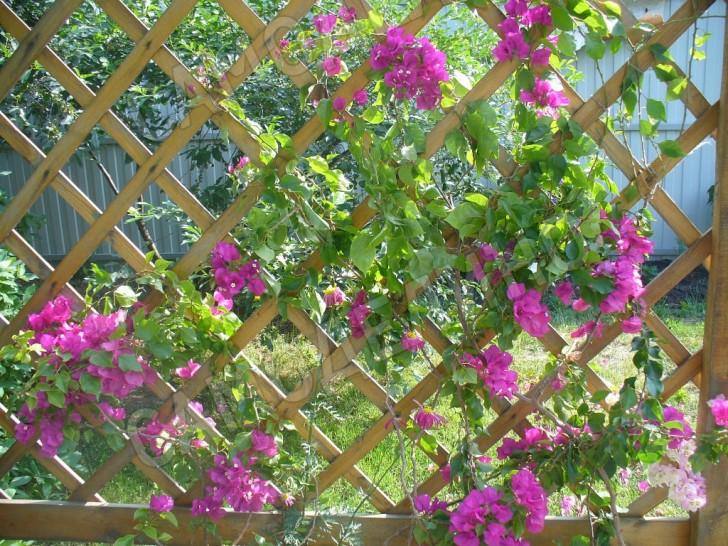

Support for cucumbers
Cucumbers are best grown upright. This allows you to quickly and efficiently harvest, and also relieves unpleasant sensations on the skin. Various hangers can help with this. They can be made of wood. For example, you can build a support - a pyramid from a bar and slats. It won't take up much space.
You can also install poles on both sides of the garden bed and pull a net between them.
Or do it differently, put a pole and plant a string around it and tie it to it. After that, we fix each rope to the ground with small pegs. The distance from the pole to the rope is 60 cm. After that, we plant the cucumbers. As they grow, they will trail along the twine.
Wooden pergolas
The wooden pergola is a rather interesting and unusual landscape gardening structure. It can be of different sizes, and be free-standing in any part of the site, or be attached to the house as a veranda. And that and that option is very interesting.
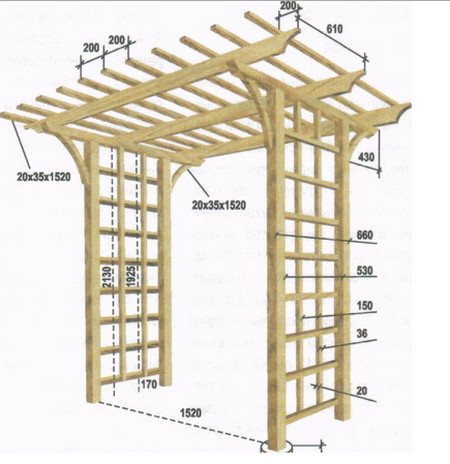

Drawing and construction of a typical wooden pergola
In order to make a wooden pergola, as a rule, use:
- oak,
- pine,
- larch,
- acacia.
The pergola can be made of one type of wood, or it can be combined. If the house on a suburban area is made in an antique style, then roughly sawed pergola elements may be suitable for decorating landscape design. If the building is modern, it will be more correct to place pergolas made of treated wood on the site. Everything will depend on the style of home decoration.


Wooden pergola for giving
Wooden pergolas made of boards and bars are fastened with galvanized screws and treated with special antiseptic agents. In order to protect the surface of such an interesting wood structure, it needs to be covered with nitro enamel in several layers, or you can use a colorless pinotex. In this case, the wood pergola will have a natural wood shade.
Varieties
The tapestry for cucumbers, raspberries, roses or grapes has varieties. A person should familiarize himself with them and decide what is right for him. Supports are:
- One-plane. These are various gratings, partitions, fences.
- Two-plane. These can be balconies, arches.
The first type is better to choose for small areas, young shrubs. Bushes that grow strongly, the second option is suitable. With the help of a two-plane trellis, you can save space, ensure an excellent harvest.
Shape of wooden structures
It is important to choose the right shape for the planned structure. It is better to make wooden garden trellises square or rectangular. The form should be cellular. The structure will be stronger if the cells are smaller. It is recommended to combine cells of different sizes: first make large, then small.
So that the do-it-yourself trellis for climbing plants was made as high quality as possible, metal brackets and corners are added. They are placed at the junction of the rails.
The two-plane frame must be more than 2.5 cm in thickness. This allows the structure to serve as a support for plants of any kind. Such tapestries for roses can be made without mounting for walls.



